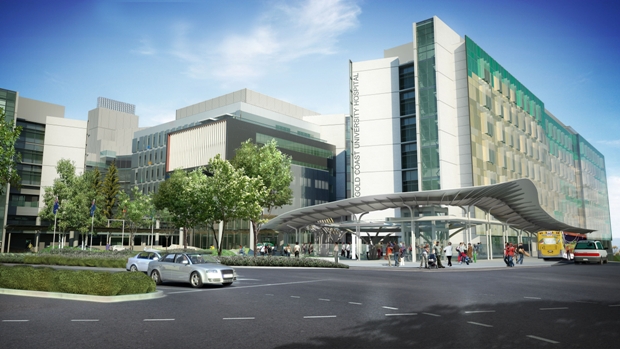The construction of the huge 1.8 billion dollar Gold Coast University Hospital has been completed under a consortium of architects who collaborated to produce a building that balanced residential elements with the clinical requirements of a hospital.
The design was realised by PDT, Silver Thomas Hanley and Hassell Architects with each firm delegated a section of the building and charged with delivering on the large scale project.
Ian Downing, director at PDT, acted as a project manager on the build to ensure that everything was documented, programmed and delivered.
"The project is a massive scale project, it's a one of a kind basically and the client had a very succinct brief as to what they wanted. We had a specific site area we were targeting for the whole project to allow for not only the brief as it stands but also for future expansions to the hospital in all areas," says Downing.

The main foyer design is reminiscent of a hotel lobby says PDT architect, Ian Downing.
The materials on the project aimed to be both clinical yet add warmth and Downing said the teams looked at residential products for the waiting areas including natural timbers as well as incorporating artwork and vistas wherever possible for a more homely feel.
The high use within hospitals informed a lot of the product choices and the Criterion Platinum 120 Aluminium suite was specified and installed for internal glazing and door jambs to create partitioning and reduce noise while Powerscape was used for the walls.
"We elected to use Powerscape on all of the walls and mainly for maintenance and protection, because hospitals are still places where they take a lot of knocking and wear and tear with bed movement, trolley movement and that sort of thing.

The main entry perspective to the GCUH.
"We've gone with a product that is a lot more durable and not requiring the same level of outer protection that would normally be required but in saying that we've still got bump rails and vinyl sheeting on the walls and acrylic sheeting in really hard wear places.
It's done more tastefully to tone down the whole appearance of what the hospital looks like," says Downing.
The main foyer is reminiscent of a hotel lobby and courtyards penetrate deep into the building to divide it and create a feeling of it not being so large.
The patient is at the centre of the design with the décor in the wards balanced between clinical requirements whilst also being a comfortable place to spend time, added Downing.
"What we were trying to do is give the patient and the visitor a nice experience of coming to a hospital to get well. The actual finishes, the way finding, the views, the external spaces, they all just add up to give a point of difference to it just being another hospital or commercial premise."

